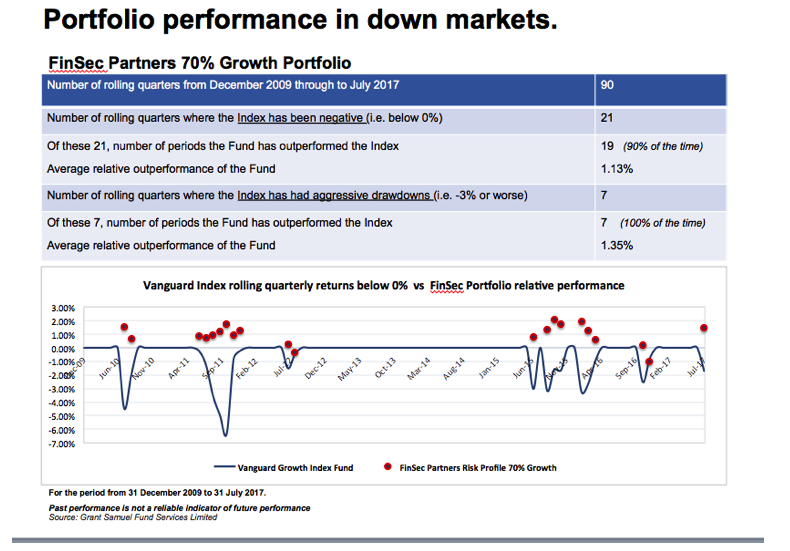Disclaimer
Information provided on this website is general in nature and does not constitute financial advice. Every effort has been made to ensure that the information provided is accurate. Individuals must not rely on this information to make a financial or investment decision. Before making any decision, we recommend you consult a financial adviser to take into account your particular investment objectives, financial situation and individual needs.
Active Investment Success Relies on Finding a Top Personal “Trainer” to do the Heavy Lifting
A mate recently cancelled his gym membership at a popular city health club, citing lack of motivation, high monthly fees and a general malaise about “just not getting results’’.
Out of interest, I asked him what his training regime looked like.
A brisk walk on the treadmill, he confessed, followed by a quick sauna and an obligatory large iced-coffee (with cream and ice-cream) in the club lounge afterwards.
Those stubborn kilos are still hanging on for dear life.
Comparisons can be drawn between my friend’s story and the heated – often hysterical – active versus passive investment debate dominating financial news headlines in recent months.
Proponents of active investment, quite rightly, argue for its superior ability to outperform the market over the long-term, with astute investor-led analysis and individual market research informing which stocks to include in any given portfolio. But active management is far more than just stock picking and here lies the often unseen value. Active management utilises all the tools available to achieve a tailored outcome for investors; asset allocation that considers the return you need at the risk you can live with, dynamic management to help avoid downside risk and ‘smooth’ the ride, precise factor exposures and even tax strategy – there is no one right way to invest for everyone. Each investor has a unique set of goals, real-world constraints and risk preferences.
This is contrary to passive investing, which follows the index, relies on trends and is often based on exchange-traded funds.
The Australian market is dominated by two sectors – banks and resources. And the top 20 Australian-listed companies account for 47% ($804 billion) of ASX200, leaving the remaining 180 stocks to make-up the remaining $900 billion.
The inherent risk with a passive Australian shares strategy tracking the S&P/ASX 200 Index is that it will overweight companies that have gone up in price and, therefore, have greater representation in the Index. So, when they fall, the portfolio hangs on for the ride from the peak to the trough – with painful consequences for total returns.
The bottom line is – markets are cyclical, what is winning today could lose tomorrow.
A philosophy that rewards past performance at the expense of future prediction isn’t an intelligent, strategic approach to creating wealth.
Also, it’s important to understand the distinction between cost and value. There is no disputing that passive strategies typically have lower fees and have done a good job of beating ‘average active managers’ (their term not ours). The key word here is average – an average manager will probably deliver average results. Our advice is to only use an excellent active manager – one who has the runs on the board, with a disciplined and robust process that is bigger than any key individual and will endure beyond the current group of people.
Find an active manager who reports their fees. Transparency is king when it comes to trust and building strong long-term relationships.
Warren Buffett once put it simply.
I just advise looking at as many things as possible and you will find some bargains. And when you find them you have to act, Buffet said.
The world isn’t going to tell you about great deals, you have to find them yourself and that takes a fair amount of time.”
The prevailing truth is that price doesn’t dictate a great company. Good investors must do proper due diligence in determining whether, firstly, they’ve found a great company and, secondly, if it’s a great company at a great price i.e. it can be a great company but the price might already reflect that in which case it is not a bargain.
There are no shortcuts. This takes thousands of hours of quantitative research, face-to-face meetings, stress testing analogies and scrutinising their balance sheets, and ongoing monitoring.
That’s the beauty of astute, wise and experienced (‘above average’) managers, they invest their time, energy, experience and the muscle to do the heavy lifting for their clients and the results speak for themselves.
Here at FinSec building sustained long-term wealth for people is at the core of ‘why we do what we do’. And, although no investment manager can ever promise they will always beat the market (if they do, run in the opposite direction) long-term wealth is only achieved with a smart, strategic and transparent investment policy and an in-house investment committee accountable to it.
It’s an approach any ‘above average’ manager should be able to prove and is best illustrated by an example of our own performance plotted below. (Blue line is the index compared with FinSec’s performance represented by the red balls).

* FinSec Partners performance compared with index June 2010 – July 2017
Which brings me back to my mate.
Him not shedding his winter weight, of course, wasn’t the gym’s fault.
He just didn’t have the right training schedule and he could have done with the disciplined, rigorous support of a qualified and experienced personal trainer who knew how to get the best out of him to enable him to achieve his goals.
